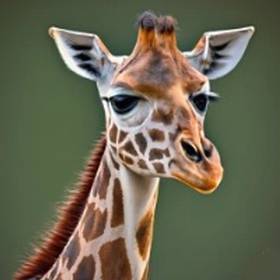What Kind of Plants Do Giraffes Eat?
Giraffes are herbivores with a diverse diet consisting mainly of leaves, twigs, and fruits from various trees and shrubs. Their unique anatomy, including their long necks and specialized tongues, allows them to reach vegetation that other animals can't access.
While they have preferences, giraffes are adaptable and will consume a wide range of plant species depending on availability and season. Their diet can vary based on their habitat and the time of year, but they generally focus on browsing from trees and tall shrubs rather than grazing on grass.
Here's a list of some common plants that giraffes eat:
- Acacia trees (various species)
- Combretum trees
- Terminalia trees
- Mimosa trees
- Commiphora trees
- Wild apricot trees (Prunus armeniaca)
- Mopane trees
- Baobab trees (leaves and fruit)
- Sausage trees (Kigelia africana)
- Fig trees (leaves and fruit)
- Bushwillow trees
- Jackalberry trees
- Umbrella thorn trees
- Tamarind trees
- Euphorbia species (in moderation, as some can be toxic)
It's worth noting that giraffes have been known to consume over 100 different plant species across their range, adapting their diet based on local vegetation and seasonal availability.
While they have preferences, giraffes are adaptable and will consume a wide range of plant species depending on availability and season. Their diet can vary based on their habitat and the time of year, but they generally focus on browsing from trees and tall shrubs rather than grazing on grass.
Here's a list of some common plants that giraffes eat:
- Acacia trees (various species)
- Combretum trees
- Terminalia trees
- Mimosa trees
- Commiphora trees
- Wild apricot trees (Prunus armeniaca)
- Mopane trees
- Baobab trees (leaves and fruit)
- Sausage trees (Kigelia africana)
- Fig trees (leaves and fruit)
- Bushwillow trees
- Jackalberry trees
- Umbrella thorn trees
- Tamarind trees
- Euphorbia species (in moderation, as some can be toxic)
It's worth noting that giraffes have been known to consume over 100 different plant species across their range, adapting their diet based on local vegetation and seasonal availability.
How Much Does a Giraffe Eat in a Day?
Giraffes have substantial dietary needs due to their large size. Here are some key quantities related to a giraffe's daily food intake:
• A typical adult giraffe consumes about 75 pounds (34 kg) of food per day.
• This amounts to approximately 1.6% of their body weight in food daily.
• They may spend up to 18-20 hours a day feeding.
• Giraffes eat around 34,000 calories per day.
• They can drink up to 10 gallons (38 liters) of water in one sitting.
• However, they don't need to drink water every day and can go several days without it.
• A giraffe's tongue is about 21 inches (53 cm) long, allowing them to gather large amounts of leaves with each mouthful.
• They may consume over 100 different species of plants, but acacia leaves often make up about 50% of their diet.
• Baby giraffes start nibbling on leaves at about 4 months old but continue to nurse until they're 6-12 months old.
These quantities can vary based on factors such as the giraffe's size, age, sex, and the availability of food in their environment.
• A typical adult giraffe consumes about 75 pounds (34 kg) of food per day.
• This amounts to approximately 1.6% of their body weight in food daily.
• They may spend up to 18-20 hours a day feeding.
• Giraffes eat around 34,000 calories per day.
• They can drink up to 10 gallons (38 liters) of water in one sitting.
• However, they don't need to drink water every day and can go several days without it.
• A giraffe's tongue is about 21 inches (53 cm) long, allowing them to gather large amounts of leaves with each mouthful.
• They may consume over 100 different species of plants, but acacia leaves often make up about 50% of their diet.
• Baby giraffes start nibbling on leaves at about 4 months old but continue to nurse until they're 6-12 months old.
These quantities can vary based on factors such as the giraffe's size, age, sex, and the availability of food in their environment.
Do Giraffes Eat Fruit?
Giraffes, the tallest mammals on Earth,
are known for their herbivorous diet, with a particular fondness for acacia trees. But do these long-necked giants ever indulge in a sweet treat like fruit?
While giraffes primarily consume leaves, they are opportunistic eaters. If fruit is available and easily accessible, they may occasionally nibble on it. However, fruit doesn't make up a significant portion of their diet. Their digestive systems are specifically adapted to break down tough, fibrous plant material, making leaves a more efficient and readily available food source.
So, while a giraffe might enjoy the occasional fruity snack, their diet primarily revolves around the abundance of leaves found in their natural habitat.
are known for their herbivorous diet, with a particular fondness for acacia trees. But do these long-necked giants ever indulge in a sweet treat like fruit?
While giraffes primarily consume leaves, they are opportunistic eaters. If fruit is available and easily accessible, they may occasionally nibble on it. However, fruit doesn't make up a significant portion of their diet. Their digestive systems are specifically adapted to break down tough, fibrous plant material, making leaves a more efficient and readily available food source.
So, while a giraffe might enjoy the occasional fruity snack, their diet primarily revolves around the abundance of leaves found in their natural habitat.



